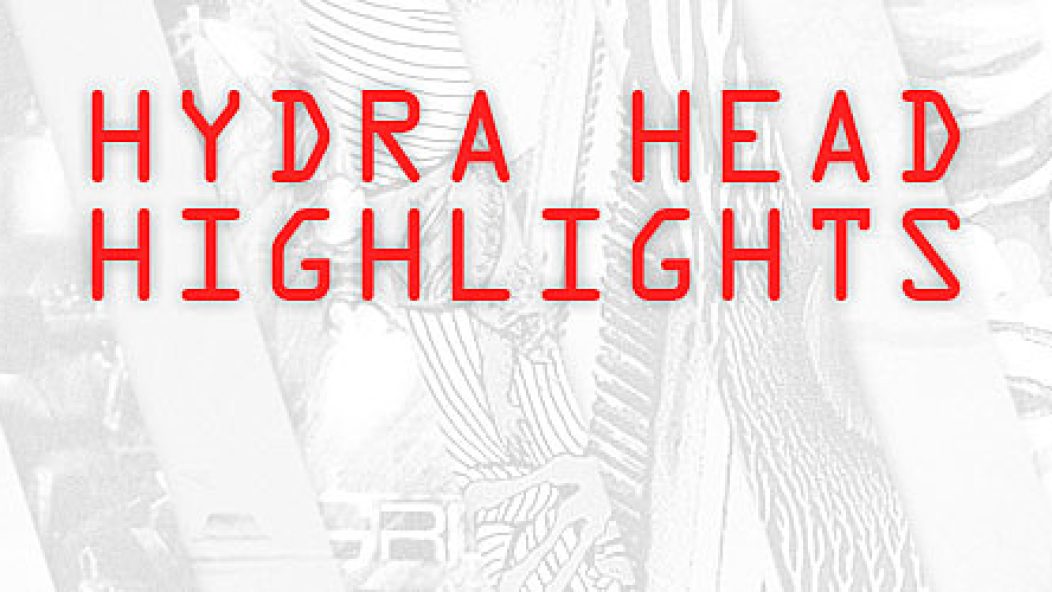
Hydra Head Highlights
. . .
From the release of HH666-01, a 7-inch by Boston band Vent, founder Aaron Turner grew Hydra Head Records to represent other local bands, then to some of the most well-known names in all of modern metal. We thought Hydra Head could never be stopped. Yet, on September 11, 2012, Turner announced that the distribution would close, and the label would release no more new music. In an effort to pay off their sizeable debts, the label would continue to make their back catalog available, while it lasted.
After releasing creative music for 17 years, it’s fair to say that many of us grew up on the music made available by Hydra Head Records. The news of the label’s demise saddened all of us here at Invisible Oranges, and led to the inevitable soul-searching and reminiscing of loss. We asked IO contributors to tell us about the Hydra Head releases that have particularly influenced them. Here, in order of release for the most part, are our favorites.
We’ll miss you Hydra Head. Thank you.
. . .
In These Blackened Days
HH666-12 through HH666-18
The In These Blackened Days 7-inch series feels like my own personal passcode into Aaron Turner’s mind. The Hydra Head catalog leaps across the whole extreme music spectrum, but Black Sabbath reduces it to the core. Tony Iommi plus Butler plus Ward plus Osbourne equals the lowest common denominator in his taste, and Turner released many of the best tributes to their work. Every one of these covers is amazing, from Jesuit’s unhinged take on “Hole in the Sky” to Cave In’s goes-down-cold-comes-up-hot take on “N.I.B.” And one could not ask for a better collection of artists (Converge, Soilent Green, Today Is The Day, the list goes on) to pay such homage. It’s a shame that the long-rumored compilation album will probably never see the light of day; it would have been not only the last time Anal Cunt and Brutal Truth share a record, but one of the finest covers albums ever pressed. —Joseph Schafer
Cave In – Until Your Heart Stops
HH666-31
Until Your Heart Stops shows a band that already had a voice and that already knew how to write songs, long and glorious songs that were as technical and as artsy as anything that came before. The thing is, Until… often sounded like other bands or other genres grafted to metalcore chugging. Bits of old school emo show up in “Juggernaut”, along with the carnival music part that takes over at 2:10. Or “The End of Our Rope is a Noose'” Down/Corrosion of Conformity-esque southern metal portions. Or the Converge-esque portions of . . . multiple songs, really. Even the song titles sound like they were lifted from Converge. The band admitted their appropriation of others’ sounds, noting that there were blatant Slayer riffs on “Ebola”.
None of it mattered though. The record is cold, claustrophobic, and brutal. It will soothe you, it will sicken you, and then it will smash you; repeat ad nauseum. That’s what makes Until Your Heart Stops great. That’s what makes it one of metalcore’s best records. —Richard Street-Jammer
Cave In – Creative Eclipses, Jupiter
HH666-38, HH666-52
It took balls the size of Jupiter to release the Creative Eclipses EP and follow-up LP Jupiter. Neither sounded like Cave In: big breakdowns and big loud-soft-loud transitions were replaced big guitar rock, big vocal hooks, and big psychedelic parts. Cave In no longer sounded cold or sickly or claustrophobic. Instead, the songs were lush and warm, drawing the listener in with open arms. This, from the band that had just birthed a metalcore masterpiece?
They were following their hearts. Reactions to Jupiter were mixed. It may have made them the biggest band on Hydra Head, but we don’t know the final record sale totals. What we do know is that it landed them a big deal on a major label, RCA. Today, we know that it was the practice run for their best record, and the second in their trifecta of meisterworks. And it showed that Hydra Head was willing to push underground music in any direction that we didn’t expect. —Richard Street-Jammer
Discordance Axis – The Inalienable Dreamless
HH666-50
My Hydra Head experience started with a CD in a DVD case: Discordance Axis’ The Inalienable Dreamless. I had read about it on some website, which made it out to be an earth-shattering masterpiece. It was indeed, from the surreal liner notes to the mind-frying sounds. That was also my first order from Blue Collar Distro, who do merch right. I still remember opening that package. It was a gateway to expanded consciousness. I started seeking out “HH666” releases after that. I am an old metal guy and always will be. But thanks to that CD in a DVD case, I started learning about a generation of bands that took heavy music to the next level: Botch, Converge, Coalesce, Cave In, the list goes on and on. Hydra Head brought this old metal guy—and I’m sure many others—into the 21st century.
—Alan Smith
Keelhaul – II
HH666-58
Keelhaul’s not one of the bigger names on Hydra Head’s roster. Unlike so many bands that released records marked with HH666-xxx, they weren’t a groundbreaking act. When II dropped, it was notable for being one of the few instrumental metal albums. If it has a claim to fame, it accidentally predicted the recent cornucopia of vocal free bands.
Except for a few guttural roars that decorate certain songs, II is four dudes from other bands locked together by the power of the Riff. II‘s greatness lies in the bands ability to write a catchy, memorable song with nothing but a riff for a hook. The vocals are mere garnishes. There are no solos. There’s no extraneous technicality and no detours into jazz or non-metallic genres. They only use the three basic metal instruments. The song titles are odd, but that’s really it. II gets by on quality. If that sounds like damning by faint praise, it’s only because the album is dwarfed on all sides by records that shifted genres or redefined how we think about metal. When comes to raw quality, II stands with the best of them. —Richard Street-Jammer
Pelican – Australasia
HH666-75
The summer of 2005 not only bridged the gap between my graduation from high school and freshman year of college, but also saw my evolution from Tool and Isis to more expansive realms. I bought Australasia a few weeks before Pelican dropped their sophomore LP, and the airy vista on the cover matched with the wordless, graceful pummeling laser-etched onto its plastic disc was a profound complement to a summer spent slinging sandwiches and staying out late with friends for what our collective emotionally-hindered, melodramatic, 18-year-old minds believed would be the last time, like, ever. It was the first Hydra Head album I ever heard and the lit match gracing its spine would ignite the coals for a post-everything feast that came to comfort me during the awkward beginnings of my new life in Eugene, Oregon. —Greg Majewski
Mare – Mare
HH666-80
Alongside contemporaries like Kayo Dot, Mare existed in their own cosmos and created some of the most authentically beautiful and simultaneously ugly hardcore imaginable in their short lifespan. No one could build a brace big enough to prepare for the scope of their sole EP and their dense compositions proved a radical challenge to the music community. When Mare delivered pretty, it was downright religious as singer and guitarist Tyler Semrick-Palmateer, formerly of The End, summoned his inner Beach Boy and delivered angelic choir passages with the subtle and haunting tones of a sinner. But when they delivered dirty, it sent paralytic shivers throughout your body, notably during the closing moments of “Sun for Miles”. In a scant 24 minutes, the Toronto trio created what is inarguably an overlooked masterpiece, an unequaled prog-jazz juggernaut, which has yet to be matched in its powerful realization. —Aaron Maltz
Gridlink – Amber Gray
HH666-120
Let’s just get the inevitable Discordance Axis comparison out of the way: Amber Gray managed to improve upon the arty, intelli-grind of The Inalienable Dreamless in half the time. In fact, Gridlink’s entire discography – all 25 minutes of it – is superior to 99% of other grindcore band’s entire catalogues. The day I first listened to a leak of this album (yes, I bought it after it came out!), I let it loop five times straight. An hour later I emerged from my apartment like a fictional survivor from the St. Valentine’s Day massacre. “What the hell just happened?” asked the reasonable side of my brain. “I’m not sure, but I’m itching to head back in and dodge some more bullets,” responded the side hellbent on self-destruction. Bryan Fajardo’s ascension to the ranks of Dave Witte and Rich Hoak as a demigod of the grind pantheon started here. —Greg Majewski
Torche – Meanderthal
HH666-152
Torche’s second full-length cruised to countless year-end accolades in 2008, and the metal public seemed to be caught largely off guard. That makes sense — even with the discography of ’90s bangers Floor and a pair of prior Torche releases under his belt, Steve Brooks hadn’t let on just how many fat fucking riffs and hooks he had on tap. They come out in a deluge on Meanderthal. The buzzword during this album’s press cycle was “thunder pop”, a self-explanatory genre Brooks made up to describe this band. Four years, another Torche album, and a dozen Torche imitators later, Meanderthal may still stand as the purest expression of thunder pop yet. Its dizzying blend of bludgeoning and bubblegum is as thrilling now as it was when Hydra Head first unleashed it on our eardrums.
—Brad Sanders
Khanate – Capture & Release / Clean Hands Go Foul
HH666-87, HH666-173
It’s difficult to pick from Capture & Release (which is two songs that give the recording its name), and Clean Hands Go Foul, Khanate’s final album. From 2005 (when C&R came out) to 2009 (for the final befouling), the music had settled into a deep, ominous, tortured place. Khanate demands that the listener enter into a tense and terrifying world, where there’s almost no movement, just scary intensity and tortured shrieking. Khanate promises nothing but an eternity of despair, which comes to an even more menacing manifestation on Clean Hands. It’s hard not to yearn for death during the 32-minute epic drone of “Every God Damn Thing”, with its synapse-breaking, desolate, scritching noises. Yet it’s also impossible not to see just how much closer to the breaking point the music can go. Alas, the band apparently reached that point, as Clean Hands Go Foul is as far into the abyss as they got.
—Vanessa Salvia
Sunn 0))) – The Grimmrobe Demos
HH666-93
As Sunn’s frequent collaborations have moved them further into the more experimental realm, I return just as frequently to their formative sounds. This one gets played often, not just because The Grimmrobe Demos is the apex of their Earth worship. It’s also that there are no vocals, no black metal overtones, no samples, no words are spoken. It’s just the band at its most distilled. It’s not that I don’t enjoy Attila Csihar’s vampiric voice, or Jessie Syke’s as a dark angel in a black robe, but here there’s nothing to distract from the sludge the music pulls you into, or grab on to when the drone erodes your soul. Southern Lord re-released this in 2005 and made it more available, but in 1998, Hydra Head was the first to unleash this awakening into the world. —Vanessa Salvia
Jesu – Silver
HH666-110
Many people, maybe most, would say that Conqueror was Jesu’s best work, but Silver is what I play time after time. Silver flows like a river of sorrow, combining the desolation of Godflesh with a gauzy pop shimmer and fuzz Justin Broadrick had never revealed before, or since. If Godflesh was the ultimate example of mechanical and industrial heartlessness, Jesu is melancholy brought to life. With Silver, Broadrick allowed Godflesh to die a beautiful death. Released by Hydra Head in 2006, Silver was Jesu’s second EP, and the only thing wrong with it is that it should have been twice as long. –—Vanessa Salvia
Daughters – Daughters
HH666-195
Daughters were once described as “music for assholes, by assholes”. While they weren’t known for their warm personalities, they were known for creating some of the more unique and confrontational “metal” during their tenure. Retaining the grindcore attributes of their former incarnation, As The Sun Sets, Daughters set out to pummel their audience with a disturbing degree of discordance that was arguably more avant-garde than metal. On their self-titled swansong, they switched gears dramatically and put-forth perhaps their most cohesive and enjoyable release. Daughters still retains the group’s notorious antagonism but is coupled with songwriting maturation and pristine production. The blast-beats and shrieks of their previous albums have disappeared in favor of something wholly singular. It’s heavy but not metal, experimental but not tedious, catchy but not radio friendly, and successfully progresses past their already unconventional vision. —Aaron Maltz
Prurient – Bermuda Drain
HH666-220-5
Bermuda Drain is typically considered the most accessible Prurient album. Instead of harsh distortion and manipulated feedback punctured by tortured screams—Prurient’s bread and butter and the stuff many Prurient fans love—Bermuda Drain has actual song structures, features esoteric spoken and intensely personal monologues in addition to Dominick Fernow’s harsh scream and relies heavily on clean synth. Hell, some of the songs are danceable, though it’s the sort of dancing that is most easily achieved in a chemically altered state.
Bermuda Drain is dark and cloaked in the seedy obscurity that Fernow has perfected, a sort of undefinable perversity of his own creation that lies beyond everyday experience. “Listen on headphones at night while driving through tunnels in Europe,” Fernow suggests. I can’t think of any better way to appreciate Bermuda Drain—time to go to Europe. —Wyatt Marshall
. . .
Tell us your favorite Hydra Head releases.












